July 18, 2008
Air Date: July 18, 2008
FULL SHOW
SEGMENTS
Gore’s Challenge
/ Jeff YoungView the page for this story
As energy issues dominate election year rhetoric, former Vice President and Nobel Laureate Al Gore laid out a challenge to candidates: completely carbon-free electricity within a decade. Living on Earth's Washington correspondent Jeff Young tells us Gore's latest campaign comes as high energy prices are eclipsing concerns about climate change. (05:30)
From Farmland to Wilderness- and Back Again
View the page for this story
In the mid 80’s, the Conservation Reserve Program paid farmers to leave some 40 million acres of farmland fallow to protect themselves from falling commodity prices. Nature has since reclaimed the unused fields, but with rocketing crop prices, many think that land should be farmed once again. Host Bruce Gellerman talks with Chad Hart of the Center for Agricultural and Rural Development at Iowa State University. (06:15)
Before and After Coal
View the page for this story
In 2004, the Chinese government shut down an old coal-fired power plant in the city of Tongliang. It afforded researchers the perfect opportunity to study the developmental effects of exposure to air pollutants both while the plant was running and immediately after it was shut down. Dr. Frederica Perera is the lead author of the study, and Director of the Columbia Center for Children’s Environmental Health. (04:30)
Living Next to Coal
/ Scott FinnView the page for this story
Residents in mining communities are used to layers of coal dust coating every surface, but there was little research on the health effects of this pollution. Now academics in West Virginia are finding residents in mining towns are more prone to lung, heart and kidney disease, and environmentalists hope these findings will help rein in the rush to coal. (07:00)
End of an Epoch
View the page for this story
Most geologists now agree that the Holocene epoch is over. In its place scientists suggest we have entered the Anthropocene, an epoch named for the human induced changes to geology. Dr. Jan Zalasiewicz is chairman of the United Kingdom Stratigrapher Commission. He explains the name change to host Bruce Gellerman. (06:10)
Inventing Niagara
View the page for this story
Niagara Falls might be one of the most photographed waterfalls in the world, but Ginger Strand, author of the new book "Inventing Niagara: Beauty, Power, and Lies," says there's much more than meets the eye. Living on Earth's host Bruce Gellerman talks with Strand about our long and often bizarre relationship with the "natural" wonder. (11:10)
Where Have All the Fireflies Gone?
View the page for this story
Lightning bugs or fireflies aren't bugs and they aren't flies..they're beetles and scientists want the public to participate in a study to find out if their numbers are declining. Host Bruce Gellerman went into the field to find fireflies. (6:00) ()
Show Credits and Funders
Show Transcript
Host: Bruce Gellerman
Guests: Jan Zalasiewicz, Francisca Perera, Chad Hart
Reporters: Jeff Young, Scott Finn
[THEME]
GELLERMAN: From Public Radio International - this is Living on Earth.
[THEME]
GELLERMAN: I’m Bruce Gellerman. The future of our civilization is at stake warns Al Gore. The former Vice President says America must abandon fossil fuels within a decade or risk losing everything.
GORE: we’re borrowing money from China to buy oil from the Persian Gulf to burn it in ways that destroy the planet—every bit of that has to change.
[APPLAUSE]
GELLERMAN: Also - the lighter side of summer. Flights of fancy that set hearts a-glow!
SOUTH: And when you see a firefly flash you’re looking at a really well-evolved courtship ritual basically.
GELLERMAN: ohhh..she’s really…
SOUTH: She’s really flashing…that’s great.
GELLERMAN: So that means she’s really hot to trot.
SOUTH: [LAUGHS] I guess so.
GELLERMAN: We take to the fields of firefly dreams. And…prepare for a shift in geological time. These stories and more, this week on Living on Earth. Stick around!
[NPR NEWSCAST: Boards Of Canada “Zoetrope” from “In A Beautiful Place Out In The Country” (Warp Records 2000)]
Gore’s Challenge
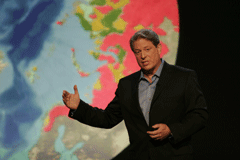
(Photo: Eric Lee, Copyright © 2006 by Paramount Classics)
GELLERMAN: From the Jennifer and Ted Stanley Studios in Somerville, Massachusetts - this is Living on Earth. I’m Bruce Gellerman, in for Steve Curwood.
GORE: Today I challenge our nation to commit to producing one hundred percent of our electricity from renewable energy and truly clean carbon resources within ten years.
[APPLAUSE]
GELLERMAN: Al Gore has thrown down the goblet. The former U.S. vice president who received the Nobel Peace Prize for his efforts to combat climate change says, “Global warming threatens our national security. Requiring us to transform our society and ourselves within ten years.” Joining me to discuss Al Gore’s pronouncement is Living on Earth’s Jeff Young. Hi Jeff.
YOUNG: Hi Bruce.
GELLERMAN: Sounds like Gore is filling in the blank, if we can put a man on the moon…
YOUNG: If we can put a man on the moon then we can be carbon free inside of ten years. That was the direct analogy that he was making here. And the timeframe is also the same as what President Kennedy used with the moon-shot challenge. Ten years. And that’s really what’s new here, is this very aggressive timetable, within a decade to greatly boost solar, wind, geothermal power and make coal fired power catch and store all of its carbon emissions, all of that inside of ten years.
GELLERMAN: But why now Jeff?
YOUNG: Well, that’s a good question because we’ve heard the broad outlines of all of this from Vice President Gore before. I think Gore sees that right now there’s so much attention being paid to the cost of fuel - the four dollar a gallon gasoline, it’s all candidates hear about on the campaign trail. It’s almost all you hear about here on Capitol Hill - gas prices, gas prices. What Gore is trying to do, I think, is to reintroduce this notion that you can’t just focus on that one aspect. You also have to look at the national security aspects of foreign oil. You also have to remember climate change. If you just attack one, you’re not going to succeed. It’s kind of like it’s the three headed hydra, it’s all the same beast.
GORE: Our dangerous over-reliance on carbon-based fuels is at the core of all three of these challenges - the economic, environmental and national security crisis. We’re borrowing money from China to buy oil from the Persian Gulf to burn it in ways that destroy the planet. Every bit of that has to change.
[APPLAUSE]
GELLERMAN: Well, it’s good rhetoric, Jeff, but ten years is a short fuse. Is this technologically possible?
YOUNG: Well, that’s the big question and that depends completely on whom you ask. I spoke with some energy experts from environmental groups who were in attendance there at Gore’s speech, and they say, “Yes, we can do this. It’s a challenge, but we can do it - we have to do it.” Other people, well, let’s just say they’re a bit more skeptical. Here’s Ohio Republican Senator George Voinovich:
VOINOVICH: Carbon free in ten years is ridiculous. I think that anybody who looks at that statement objectively, that knows anything about it would have to say that it’s ridiculous.
YOUNG: And I think that a lot of Republicans see a political opportunity here: that if Democrats begin to place an emphasis on climate change and a potentially costly approach to climate change, they can turn this and say, “Ah ha. See they’re just interested in this one thing. They don’t care about your pocket book concerns.”
GELLERMAN: Now Jeff, Al Gore has supported Barack Obama and his bid for the presidential nomination, right?
YOUNG: Yeah, he gave him a full-throated endorsement.
GELLERMAN: Do you think that he is saying what Obama can’t at this stage of the campaign?
YOUNG: I think that that’s a fair way of putting it. I think that, uh, what Gore is doing here in a way is kind of broadening what it is possible for people in the political realm to talk about safely. And, so Senator Obama, for example, uh, issued a statement after Gore’s speech saying, “We applaud the speech and he’s a champion on this…” but didn’t specifically say or endorse any of the ideas - like the ten-year timeframe and the carbon tax that would come along with that.

(Photo: Eric Lee, Copyright © 2006 by Paramount Classics)
GELLERMAN: But not floating a balloon.
YOUNG: Not exactly, but you know, the politics and the cost of this are interwoven. You know, the question is, “Ok that’s great, but how are we going to pay for it, and how much is it going to cost, and what’s going to be the economic impact?” And that’s the vulnerability that I think, uh, Republicans are going to want to exploit. And that’s where, uh, Gore wants to get his argument out there. And his argument essentially is this: look, if you focus on, drilling, the supply side of our oil problem, the global demand is such that China is just going to suck all of that up. They’re going to drink our milkshake as they said in that great movie. So it doesn’t matter how much supply we create, what we need to do is attack the demand side.
GORE: When demand for oil and coal increases, their price goes up. When demand for solar cells increases, the price often comes down.
[APPLAUSE]
GORE: That’s the difference.
YOUNG: So, you know these questions: How much is going to cost? And can we afford it? And is it technologically feasible? You know what…I think that those are the same kind of questions, the same kind of debate that people where having somewhere around 1961, 1962 after Kennedy made the moon-shot challenge.
GELLERMAN: Hum. And then about nine years later astronaut Neil Armstrong was making one giant leap for mankind.
YOUNG: There you go. So maybe this is doable.
GELLERMAN: Well, thank you very much Jeff.
YOUNG: You’re welcome Bruce.
GELLERMAN: Living on Earth’s Washington correspondent, Jeff Young.
Related links:
- Al Gore’s speech
- Jeff Young's 2007 interview with Al Gore
[MUSIC: Garage A Trois “Antoine” from ‘Outre Mer’ (Telarc—2005)]
From Farmland to Wilderness- and Back Again
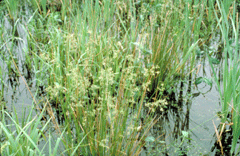
A wetland thrives on former farmed land in Ohio. (Courtesy of the Environmental Protection Agency)
GELLERMAN: since 1985, the federal government has paid farmers for fields they don’t sow. It’s called the Conservation Reserve Program. And it was designed to stabilize the price farmer’s got for their crops by limiting production. The CRP worked and then some. Not only did it save family farms, it also helped restore millions of acres of land that lay fallow. Benefiting the environment and wildlife. However today, with prices of farm commodities soaring, many farmers in the U.S. Department of Agriculture want to put the fallow fields back into production. But the National Wildlife Foundation says, not so fast. The environmental group won an injunction in federal court keeping the lands off-limits. At least temporarily. And that’s where things now stand with the CRP. We invited Chad Hart and agricultural economist at Iowa State University in Ames, to tell us where things are going. Hello Mr. Hart.
HART: Well it’s a pleasure to be here Bruce.
GELLERMAN: The Conservation Reserve Program as I understand it has really been a success story.
HART: It has been. It’s an environmental program around about 20 years. We’ve got around 35 million acres in the program preserving some environmental benefits.
GELLERMAN: Well providing environmental benefits by taking the land out of circulation and also providing an economic boost to family farms. It’s really helped them.
HART: It has. It was established at a time of low commodity prices and so the rental rates that the farmer’s received were a definite boost to their income.
GELLERMAN: Well how does it work? The farmer essentially gets paid not to grow on his land?
HART: The farmer sort of receives, if you will, essentially a rental rate to keep that land out of production. So it is based upon the productive capacity of the land and the farmer agrees in the contract to say, “Oh okay I’m not going to plant this land for the next ten years,” in exchange for that payment.
GELLERMAN: Hm, how much does he get?
HART: It varies. I think nationwide average is around 50 dollars an acre. For your higher producing land such as here in Iowa, more like a hundred dollars an acre.
GELLERMAN: So if a farmer was to raise say corn on his land in Iowa these days, how much would he get?
HART: On Iowa these days given the prices that we’re seeing today you’re talking about net returns probably on the order of six to seven hundred dollars an acre.
GELLERMAN: Ooh, so if I was a farmer who had signed on to CRP, I’d want to opt out, right?
HART: Given the prices we’re seeing today that makes it highly attractive to opt out of the CRP program.
GELLERMAN: And what would it cost me to opt out? I mean I signed a contract with the federal government.
HART: Yeah, you’ve signed the contract. And your penalty would be you would have to repay everything you’ve received on that contract so far plus at least 25 percent of the next year’s payment that you would receive.
GELLERMAN: So what does the Department of Agriculture propose doing?
HART: Well at least in the near term what they proposed in May was that they would release on a short-term basis CRP lands in order for emergency hanging and grazing where farmers could release livestock on the land to graze the land or they could harvest the forage on the land and feed that to their livestock. What we’ve seen with the droughts especially in the Southeast and Southwest and the flooding here in the upper Midwest, we’ve seen some sizable impacts on our agricultural production over the last couple of years. And so we’ve opened up CRP lands to grazing for livestock. Now the question becomes as we look down the road beyond this year, if they continue to have dry weather, what happens then?
GELLERMAN: Well and it’s not only cattlemen that would want relief from CRP.
HART: No, it’s not. What we’re seeing especially with the higher corn, soybean, and wheat prices we’re seeing today, you’re seeing pressure from other users of those products in order to try to bring prices down and one way to bring it down is to plant more land to those crops and produce those crops.
GELLERMAN: How does ethanol—corn-based ethanol—factor into the CRP?
HART: Corn-based ethanol would factor in mainly due to impacting commodity pricing. And so when we look at this economic opportunity that farmers have with the possibility of bringing CRP land out into production, one of the reasons for wanting to do that would be to produce more crops which would be utilized for biofuels. And so that’s one of the many reasons why we’ve seen higher commodity pricing and the attractiveness of opting out of the CRP program.

A wetland thrives on former farmed land in Ohio. (Courtesy of the Environmental Protection Agency)
HART: Well in Iowa, like I say, we’ve seen much more wildlife habitat especially when we think about the Ring-Neck Pheasant for example. They utilize the buffer strips along the waterways that many of those are in the CRP program. You’re also seeing a reduction in soil erosion throughout Iowa due to the conservation practices and having this land idle at least for a ten-year period. That helps bring down the amount of soil entering into our water streams and flowing down to the Mississippi River Valley.
GELLERMAN: Well the National Wildlife Federation has sued the Department of Agriculture and gotten an injunction in federal court.
HART: Yeah we are seeing competing interests in looking at the CRP program and the changes that are being not only implemented but future proposals in changing the CRP program, how that’s going to play out between the environmental benefits we get versus the economic benefits of bringing that land into production.
GELLERMAN: Well can we do both? Is there a way of balancing the conservation and balancing the farmer’s need for finances?
HART: I think there is a possibility of that balance but it does take modifications to the program. Not all CRP land is as environmentally sensitive as any other piece. There are some more sensitive pieces that should be targeted to be kept within the CRP program. At the same time, having some of that, what we call the less marginal land, brought back out into production would help lower prices.
GELLERMAN: So you’ve got droughts, you’ve got floods that are affecting farmers, you’ve got the ethanol production raising the commodity prices…
HART: We’ve had a sort of perfect storm in terms of our commodity pricing and that there have been a lot of factors that have created a higher price situation out there and so that’s why we’re re-evaluating how we look at the CRP and how we target land to be in that program.
GELLERMAN: Well Mr. Hart I want to thank you very much I really appreciate your time.
HART: Well thank you very much it was a pleasure to be here Bruce.
GELLERMAN: Chad Hart is with the Center for Agricultural and Rural Development at Iowa State University.
Coming up new studies about coal. It’s a burning issue in China and a health hazard closer to home. That’s just ahead on Living on Earth.
Related link:
The USDA’s Conservation Reserve Program
[MUSIC: Bajofondo: “Cristal” from Mardulce (Decca Records 2008)]
Before and After Coal
GELLERMAN: It’s Living on Earth, I’m Bruce Gellerman.
In 2004 Chinese Government shut down a coal-fired power plant in the Midwestern city of Tongliang. The plant closing provided researchers with a unique opportunity to study the effects of the coal pollution on the development of children in the area. Doctors Deliang Tang and Frederica Perera with the Columbia Center for Children’s Environmental Health conducted the research in China. Their study now appears in the latest edition of Environmental Health Perspectives. Dr. Perera is the Director of the Center. And Dr Perera –seems you got lucky with the closing of this coal-fired power plant.
PERERA: We certainly did. These are rare opportunities where one can actually study and measure the benefits of an intervention—in this case, the closure of a polluting coal-fired power plant. And that allowed us to enroll one group of pregnant mothers and their babies and follow them for several years and then enroll a second group after the plant had been shut down and compare their exposures and their developmental outcomes.
GELLERMAN: So what did you find?
PERERA: Well when the babies were more exposed they had higher levels of the pollutants in their umbilical cord blood and they fared less well on the developmental tests at age two, particularly in the motor area. And we’re certainly not talking about loss of IQ points here but the test is intended to detect children who are intellectually at risk and in need of remediation to avoid later problems in academic performance.
GELLERMAN: How significant were the differences in these two groups of children?
PERERA: There was a 40 percent reduction in the level of exposure as we measured it and a 60 percent reduction in the frequency of developmental delay in the motor area.
GELLERMAN: What pollutants were you looking at specifically?
PERERA: Oh specifically we’re looking at the polycyclic aromatic hydrocarbons. And these are known as PAHs. They are very common combustion products from coal burning and burning of other organic material. And they do many things. They’re known carcinogens as well as developmental toxicants.
GELLERMAN: How polluting was this power plant that closed down?
PERERA: Well the power plant was fairly polluting. It burned 25,000 tons of coal a year. It emitted particulates and SO2 at a rate exceeding the US standard certainly and the Chinese standards and that was the reason why the government had ordered shutdown not only this plant but of the entire category of the older power plants.
GELLERMAN: What about these new modern coal fired power plants that China’s now building?
PERERA: Well I think these newer power plants will certainly be less polluting than the one we were studying, no question about it. And of course one can’t directly extrapolate from one study in a setting such as the one we had here to others but I can say though that in our studies in other countries in the U.S. and in Poland at lower levels of exposure than we were measuring here in China we could detect significant effects on early child development as well as on fetal growth.

Dr. Federica Perera.
GELERMAN: Of course China’s producing three-quarters of its electricity from coal-fired power plants.
FERERA: That’s correct. I think China as well as many other countries are working very hard now to achieve more independence from fossil fuel and also to switch to renewables and efficient utilization of energy but in the meantime I hope that our study will be helpful in showing the good news from an action by a government and recording that benefit in terms of child health.
GELLERMAN: Dr. Frederica Perera is Director for the Columbia Center for Children’s Environmental Health. Well Dr. Perera I want to thank you very much.
PERERA: You’re most welcome.
Related links:
- To read Federica Perera's study, click here
- Fore more on coal, check out Living on Earth's series "Generating Controversy"
Living Next to Coal
GELLERMAN: It’s not just residents who live near coal-fired power plants that can be harmed. Those who reside in mining communities can suffer too, ‘though scientist have conducted little research about them until now. A new study out of West Virginia University finds that people in coal mining communities are much more likely to suffer from lung, kidney and heart disease – even if they never worked in a mine. Environmentalists’ hope the study can help slow the growth of mining in Appalachia. Scott Finn has our report.
[NATURAL SOUNDS, BULLDOZER BEEPING]
FINN: For years, dust blew off stockpiles of coal and rained down upon the little town of Sylvester – a tiny community of neat, one-story homes squeezed between a steep mountain and the Coal River in southern West Virginia.
In 2001, some residents of Sylvester, fed up with the dust, sued mining company Massey Energy, and eventually, the company was forced to cover one of those coal piles. Now a huge, white geodesic dome looms like a spaceship over the town.
[NATURAL SOUNDS, COAL TRUCK PASSING]
FINN: But it hasn’t stopped the dust from the other piles of coal, or the huge trucks that travel the main road.
That’s why Michael Hendryx, a West Virginia University researcher, is visiting Sylvester - to measure the level of air pollution.
HENDRYX: This is a what you call a shoestring operation.
[LAUGHS]
[SQUEAKING TRAIN WHEELS]
FINN: Today, Hendryx is standing on the porch of a house about 1,000 feet from a facility where they crush and prepare the coal to be transported. A coal train inches along nearby.
HENDRYX: What I’m trying to do is just homemake a little protective device that will hang this air monitor so it will be protected from the rain, but will also allow a free airflow into the monitor, so we can record the level of particulate matter that’s in the air around here.
[SQUEAKING TRAIN WHEELS]
FINN: He takes an air quality monitor – it’s about the size of a hardback book – and places it in what looks like a metal cage.
FINN: And where did you get this wire here…
HENDRYX: That’s a toilet roll holder that I bought at Wal-Mart. [LAUGHS]
[SQUEAKING TRAIN WHEELS]
FINN: Then, he wires the entire contraption, upside down, from a rafter on the porch. It will measure the amount of particulate matter – basically, coal and rock dust particles – in the air.
This is phase two of Hendryx’s research. In phase one, he compared the rate of disease in West Virginia’s coal mining counties to counties with no mining. He made sure to take into account any health differences based on things other than coal, such as smoking rates, education and income.
Hendryx found that people in coal mining communities have a 70 percent increased risk for developing kidney disease, a 64 percent increased risk for developing chronic lung disease, and are 30 percent more likely to report high blood pressure. His work was published recently in the American Journal of Public Health.
Men and women are equally affected - and since most coal miners are still men, he says the results support his working hypothesis - that exposure to coal pollution causes higher rates of disease, not just for coal miners, but for everyone in the community.
Now, Hendryx is measuring the levels of air pollution around coal facilities.
[ENTERING HOUSE]
FINN: After he hangs the air monitor in place, Hendryx goes inside Elizabeth Casto’s house and sits on her powder blue couch. He tells Casto and her sister, Pauline Canterberry, about some early results from his air monitors in Sylvester.
HENDRYX: …he found that the levels of particulate matter were highest as you were closer to the facility, and falls off as you move away.
[AMBIENCE OF HOUSE]
FINN: Casto and Canterberry are part of a group that fought the coal plant in court and forced Massey Energy to build the strange geodesic dome. It’s how they earned their nickname: the Dustbusters.
HENDRYX: So there’s evidence that the levels of air pollution are in fact impacted by the activities of the mining industry that’s going on.
CANTERBERRY: We know that. We definitely know it out here. (laughs)
HENDRYX: Well, we all know it, but we have some evidence now.
CANTERBERRY: We’re had some huge doses of it…
FINN: The connection between coal pollution and disease seems obvious to coalfield residents. Casto’s husband, Perry, was a disabled miner with black lung – and the dust in the air aggravated his disease.
CASTO: Just choked himself to death, and his heart doctor said, “No way.” So we went back to Florida. He just begged us to bring him home. What are you going to do? There’s just no way.
FINN: Perry Casto died in 2003 - in Florida instead of his hometown of Sylvester.
Hendryx is trying to move from personal experiences like this to concrete evidence – evidence that environmentalists have been waiting for. Joe Lovett, executive director of the Appalachian Center for the Economy and the Environment in Lewisburg, West Virginia, says the research could be crucial in future lawsuits challenging the coal industry.
LOVETT: Lawyers will usually represent people for that kind of thing, particularly if they think that liability is easily established. So the kind of work that’s going on might show that there’s injury occurring and that brings lawyers around.
If I lived in a community and somebody wanted to build a prep plant near me, I would do everything I could to try to keep that prep plant out of my neighborhood.
FINN: In fact, Hendryx is talking to lawyers for a community in Kentucky that’s fighting a proposed coal preparation plant like the one in Sylvester. They’re demanding the coal company build the plant farther from town – or at least take steps to control the dust.
Environmentalists say that lawsuits are the only way to get the coal industry’s attention. But Hendryx is getting no support from state officials for his research. West Virginia Governor Joe Manchin, a former coal broker, says his administration doesn’t have the resources to help.
A spokesman for the West Virginia Coal Association did not respond to a request for comment on this story.
[SOUNDS OF TRAINS]
FINN: Outside her sister’s home, Pauline Canterberry points at the steep hills surrounding her town, and from east, west, north and south, surface mines are creeping closer.
CANTERBERRY: Sylvester right now is the central point. It’s coming this way. That way there is Prenter, and you know what Prenter is. It’s one permit after another.
FINN: Coal prices are at record highs, and since 2003, production is up ten percent in West Virginia.
Canterberry and the other dustbusters are looking for ways to slow down the onslaught – and they’re hopeful that Hendryx’s research is just the ammunition they need.
For Living on Earth, I’m Scott Finn in Sylvester, West Virginia.
Related link:
Check out Living on Earth's series on coal, "Generating Controversy"
[MUSIC: Marc Ribot “Girlfriend” from ‘Ceramic Dog’ (Pi Records—2008)]
End of an Epoch

(Photo: Rick Zhuang)
GELLERMAN: In case you hadn’t noticed, we’re living in a whole new Epoch. Goodbye Holocene, Hello Anthropocene. For the last 10,000 years or so we’ve been blessed with an unusually mild and consistent climate but stratigraphers - the experts who decide this stuff - say we’re now in a whole new scene brought on by us. The International Commission on Stratigraphy will soon be meeting in Norway to make the epoch changing name official. Jan Zalasiewicz is chairman of the United Kingdom Stratigraphy Commission based in Leicester, England.
ZALASIEWICZ: Well if we look at the changes that are taking place now and have taken place over the last couple of centuries in terms of changes to atmospheric composition, soils and sediments, changes to the biology of the Earth. We consider that as comparable to some of the great changes of the geological past. Hence we propose that formally we’re no longer in the Holocene; that we’re in the Anthropocene.
GELLERMAN: Well when did that happen?
ZALASIEWICZ: Well the great change from if like a time when humans were around and having an impact but not a global impact to humans really changing the surface of the Earth probably started about the Industrial Revolution so that would be about the year about 1800 or so when the human population went over a billion and also, crucially, humans started using coal, oil, gas to hugely amplify the energy they could exploit.
GELLERMAN: The idea is that civilization, human civilization, has changed geology.
ZALASIEWICZ: That’s right, yes, yea, because if you were to look at the changes we’re making, for instance, the changes to the Earth’s biology, great changes on land and changes in the sea as well, with many species becoming extinct, many others being translocated to different parts of the globe, that will translate into the future fossil record, and probably already we’re making quite a distinctive signal that will be detectable for many millions of years afterwards.
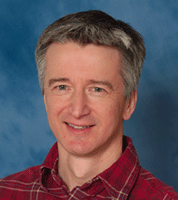
Jan Zalasiewicza
ZALASIEWICZ: Yes, almost certainly, in fact undoubtedly. We’ve already made a number of species extinct. And I think one, entirely novel effect, is the way that we’ve transplanted many species of animals and plants from one continent to another, from one ocean to another, and the effect of that is still unpredictable but it will be large and will translate into geology.
GELLERMAN: So stratigraphers in the distant future, your colleagues, will be digging through the record, and they’ll come across: Anthropocene.
ZALASIEWICZ: They will almost certainly see a change in the rocks of the future. So the change might include let’s say an extinction event, much like the extinction event that we can see that took place around 65 million years ago when the dinosaurs and many other creatures died out. They may well see evidence changes in sea level, they may see evidence of changes in the chemistry of the oceans, for instance the oceans becoming more acid and hence literally dissolving parts of the sea floor where you’ve got deposits of lime, of calcium carbonate at the moment.
GELLERMAN: Plus all the artifacts of our generation – all the plastic, the concrete, the steel, the cars, all the junk.
ZALASIEWICZ: That’s right, yes. A city is for us something we live in, but it’s also a very material object which in effect will form a future stratum you know all of that concrete, and brick, glass and tarmac, asphalt—that is potentially preservable and that will make a very distinct rock type.
GELLERMAN: So if we were going through the geological record say 15,000 years in the future would you find a bright big demarcation in that record, you’d know when you hit the Anthropocene?
ZALASIEWICZ: Yes I think if you had looked even 15 million years in the future then the changes that we’re causing right now are geologically abrupt, almost instantaneous, in fact 15 million years in the future the changes that are happening right now will look almost akin to that of the meteorite strike which it is thought killed off the dinosaurs at the end of the crustaceous period. You know it is we’re looking at that level of rapidity.
GELLERMAN: So Dr. Zalasiewicz how consequential are humans in terms of you know, the natural cycles of the Earth? I mean gravity and erosion are the forces that are really shaping the planet, right?
ZALASIEWICZ: They are. In terms of lets say landscape formation, erosion, denudation, and so forth then yes gravity, water, wind, waves, and so on. There have been a few recent studies, including some published by the Geological Society of America, which have suggested that humans have now taken over the top stop as regards eroding the surface of the Earth, as regards transporting masses of soil and rock and sediment around the surfaces of the Earth.
Again its another of the symptoms of the Anthropocene and that is both the sediment transported as we build things, as we build our cities, and roads, and bridges, and so forth and also sediment transported as we convert a large part of the landscape into feedstock and agriculture moves a lot of sediment around simply as a byproduct of farming.
GELLERMAN: We’re also at the edge of going to other planets and changing their geology.
ZALASIEWICZ: That’s right, yeah.
GELLERMAN: So it could be not just Earth-bound geology that you’re gonna be dealing with in the future but planetary, the Age of Planetarium?

If geologists are still around millions of years in the future, they will be able to see a clear line of strata that indicates the Anthropocene, showing sea level rise, translocation of species, and increased carbon dioxide. (Photo: Rick Zhuang)
ZALASIEWICZ: Well that’s right there’ve been ideas which are partly in the realm of science fiction of going let’s say to Mars and if you like Terra-forming it, trying to alter conditions of the atmosphere and such like you know to make it more habitable. Whether that is realistic or not it’s hard to say but those ideas have been floated as they have for Venus. It’s interesting also that in this context the word terra-forming has been applied to colleagues of mine with respect to Earth. That humans are in effect now terra-forming the Earth.
GELLERMAN: Boy this is exciting stuff.
ZALASIEWICZ: It is. We live in a remarkable time geologically and what’s really exciting is that just at the moment as humanity is got the power to change the planet it’s also got the ability to reflect on the changes that it’s causing to Earth.
GELLERMAN: Well I want to thank you very much. I really appreciate your time.
ZALASIEWICZ: Thank you very much indeed.
GELLERMAN: Jan Zalasiewicz is chairman of the United Kingdom Stratigraphy Commission.
[MUSIC: Bajofondo “Grand Guignol” from ‘Mardulce’ (Decca Records—2008)]
GELLERMAN: Coming up: who turned off the lights? We go hunting for fireflies. Stay tuned to Living on Earth!
ANNOUNCER: Support for the environmental health desk at Living on Earth comes from the Cedar Tree Foundation. Support also comes from the Richard and Rhoda Goldman Fund for coverage of population and the environment. And from Gilman Ordway for coverage of conservation and environmental change. This is Living on Earth on PRI—Public Radio International.
Related link:
United Kingdom Stratigraphy Commission Homepage
[MUSIC: Monty Alexander: “Jammin” from Stir It Up: The Music OF Bob Marley (Telarc 1999)]
Inventing Niagara
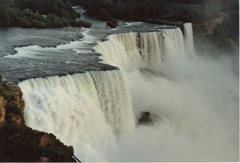
(Photo: John Hackston)
GELLERMAN: It’s Living on Earth. I’m Bruce Gellerman. Niagara Falls: the name comes from the Iroquois Indian word meaning: thunder of waters. And thunder it does…
[SOUNDS FROM NIAGRA FALLS – WATER THUNDERING]
GELLERMAN: Three quarters of a million gallons of water a second cascades over Niagara; one fifth of the world’s fresh water flows over the falls. It’s an awe-inspiring site: the falls’ natural beauty and hydroelectric energy competing forces that over the years have attracted honeymooners and developers, daredevils and corporate polluters. The story of the history and transformation of the falls is told by Ginger Strand in her new book: “Inventing Niagara: Beauty, Power, and Lies.”
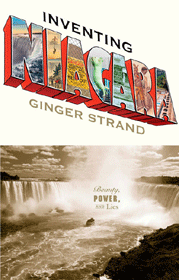
STRAND: I think that’s true, yeah. There are pictures of it everywhere, right. And there’s a sense in which it is the iconic American landscape in that you haven’t been to America until you’ve seen the falls.
GELLERMAN: But it’s interesting that something so awesome and something so magnificent can have so little that’s genuine about it. They try to control just about everything, they try to control not just the water going over but the mist.
STRAND: That’s right. This is what fascinated me overall at every step of the way it was a kind of contest between humans and nature and you know we were always stacking the deck. The international control structure that’s upstream of the falls people look at that and they think that it has something to do with water diversion, it helps water go into the tunnels or something. It has nothing to do with water diversion, it’s just to redirect the water to make the falls look pretty.

(Photo: John Hackston)
STRAND: Mhmm. There’s a lot of rocky rubble—they call it tallis—at the base of the American falls, and the Army Corps of Engineers decided, in their infinite wisdom, that they should clear all those rocks away because they’re really not very pretty and people would rather see the waterfall looking bigger and more muscular. So they turned off the falls, and they drilled core samples and studied the whole rock face and they realized that if they took the rocky rubble away the whole thing would collapse. It’s actually holding up the waterfall. So they changed their mind about that.
GELLERMAN: I want to ask you about daredevils. Niagara Falls of course is synonymous with people who are walking tightropes, and people going over it in a barrel. There was a guy named Blondon, did I pronounce that correctly?
STRAND: Yes. Yes.
GELLERMAN: And he actually carries somebody, his manager, on his back as he’s walking across the wire.
STRAND: On a tightrope yeah. And what Blondon was doing was to some extent a commentary on the upcoming Civil War and the Underground Railroad. You know, Niagara Falls was one of the key crossing points into Canada for fugitive slaves. And the only place where they could get across to Canada that was serviced by public transportation was Niagara. They could take a train ride up and they could go across the bridge or they could row across the river. And this was just, it was a national spectacle throughout the 1800s but especially the 1850s. People were crossing on a daily basis into Canada. And everyone was fascinated by this. And it’s 1859, 1860 when Blondon does his famous tightrope performances at the falls and he does them in shackles, and he does them with a sack over his head, and he does them in the middle of the night with a sack over his head. I mean, they’re incredible performances but I also began to think, “Wow, this guy was making a sly but pointed comment.”
GELLERMAN: Tell me about Annie Taylor. How old is she when she goes over the falls in a barrel?
STRAND: She was 63. She lied, she said she was 43, but she was 63. An unemployed dancing teacher from Bay City, Michigan and she was the first person to survive going over the horseshoe in a barrel.
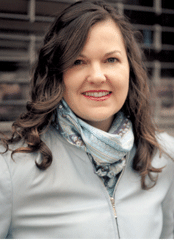
Ginger Strand. (Photo: Orianna Riley, Courtesy of Simon & Schuster)
GELLERMAN: How did Niagara Falls become the honeymoon capital of the world?
STRAND: Well the honeymoon is not as old an institution as we tend to think it is. It kind of got going as a popular thing to do in the early 1800s and that was about the same time that Niagara became accessible. It became accessible in 1825 when the Erie Canal arrived nearby and people could suddenly get up there conveniently. So Niagara became the sort of peak, the sort of climax of the American Grand Tour, they called it the Northern Tour.
GELLERMAN: Of course it really got a boost when Marilyn Monroe starred in “Niagara.”
STRAND: Yes, absolutely.
[MARIYLN MONROE SINGING “TAKE ME TAKE ME IN YOUR ARMS”]
STRAND: When Marilyn came in 1952 and they filmed “Niagara” it became an epidemic at the fall—everybody called up and they wanted to stay at the hotel that Marilyn stayed in, which of course didn’t exist, it was a set.
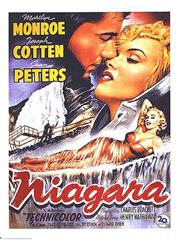
GELLERMAN: And of course it was Dupont, the chemical company, which was responsible for so much of the toxic waste that wound up getting dumped into the river and therefore over the falls.
STRAND: That’s right, Dupont, and Hooker, and ElectroMet, UnionCarbide—a whole slew of the American electrochemical industry was centered at Niagara Falls for many, many years.
GELLERMAN: Right, HookerChemical of course with Love Canal.
STRAND: Yes, it was appalling and it went on for decades, the dumping. It was an abandoned hydroelectric canal begun many, many years earlier where just all sorts of things were dumped and I think they identified 82 separate chemicals when they finally did begin testing that were leaking into peoples basements and showing up on playgrounds, children were turning up with strange burns. There were miscarriages and birth defects.
[SOUNDS FROM A NEWS REPORT ON TOXIC WASTE]
STRAND: And many people are familiar with Love Canal as the beginning of the Environmental Justice movement. This is when people began to talk about where these places are sited and the kinds of working-class people who tend to bear the burdens of hazardous waste. But few people realize that it’s actually a stone’s throw from the Niagara River so this toxic brew was going over the falls.

Love Canal residents protest the toxic waste dump. (Courtesy of the Environmental Protection Agency)
STRAND: [Laughs] Yes, one of the creepier things that’s buried there but certainly not the only one. They had the capacity to do uranium diffusion at Niagara Falls because there were all of these chemical companies who had been experimenting with uranium already, the electrometallurgical companies had the ability to roll the uranium into rods to be used in nuclear reactors. So they did all that work at the falls. There are actually 13 sites that are now being cleared up by the Army Corps of Engineers as former Manhattan Project contractors in the county. And you know it all boils down to our human drive to master the waterfall and in 1895 they really did that. They, you know, Tesla and Westinghouse managed to harness the falls and utilized the massive amounts of electricity that they could produce and from then on, Niagara became the site of all the industries that were interested in cheap electricity. So electrochemical, electrometallurgical, anyone who used electricity in manufacturing their product. And at that time there were no regulations about disposing of waste, whether it was hazardous waste or just normal waste, and so it just got dumped all over town.
GELLERMAN: So what’s the lesson of Niagara Falls’ history?
STRAND: I think that the lesson of Niagara is that you really can’t separate human history from natural history. And we have this funny notion of nature as this thing that’s out there, and it’s kind of separate from us, and we’re either going to use it or we’re going to deify it, put it on a pedestal and look at it and say, “Oh isn’t it beautiful.” And I think that the reality of the way we live in the environment is much more complicated than that. For instance, with the water diversion of Niagara, I’m not against hydrodiversion, I think hydro’s relatively benign when it comes to ways that we produce electricity, but it does have a price. And I’m fascinated that we are so interested in disguising that price because it makes it that much harder for us to know when the price is becoming too high.
GELLERMAN: Well Ginger it’s been a real pleasure. Thanks very much.
STRAND: It’s been my pleasure.
GELLERMAN: Ginger Strand is the author of the new book "Inventing Niagara: Beauty, Power, and Lies.”
Related link:
For more on Ginger Strand and her book, click here
[MUSIC: Marilyn Monroe “Kiss” from ‘The Magic Of Marilyn’ (DRG Records—2001)]
Where Have All the Fireflies Gone?
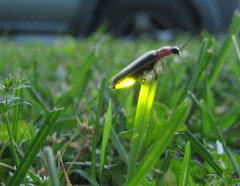
(Photo: Scott Craig, aka Saintbridge at Flickr.com)
GELLERMAN: Finding fireflies is great summertime fun. But before you head for the fields in search of fireflies or lightning bugs as they’re also called…there are a few things you should know: First: they’re not bugs, they’re beetles. And they’re not flies…
[CRUNCHING SOUNDS OF WALKING THROUGH GRASS]
GELLERMAN: And second: the best time and place to find the blinking beetles is at dusk in wet, tall grasses…which also happen to be the perfect conditions for man-eating mosquitoes.
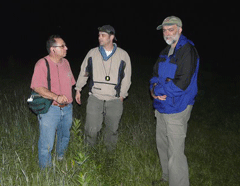
Bruce Gellerman sets out with Adam South and Don Salvatore (right).(Photo: Bruce Gellerman)
GELLERMAN: Adam South, a biology grad student at Tufts University and Don Salvatore, an educator at Boston’s Museum of Science, are lightning bug experts….and armed with industrial strength mosquito spray. They’ve come to this soggy field in Lincoln, Massachusetts at the edge of the evening well prepared to find fireflies.
Ok so you ready to go.
SOUTH: Yeah, just let me grab my net, stop watch, I got my head lamp..
GELLERMAN: Adam South straps on a blue light headlamp—fireflies can’t see the color blue—then he leads the way …but finds barely a flicker.
SOUTH: Usually there are a lot of fireflies out now but this year has been a really bad year for the species here, photinus greeni. It was so dry this last August we think it just ended up killing a lot of the larvae, so this year’s there’s been almost nothing in the upper field. Unfortunately.
GELLERMAN: Lightning bugs are rarely seen west of the Rockies but there are scores of species on the east coast, though in recent years their numbers seem to be dwindling. So South and Salvatore have teamed up for a summer project sponsored by Boston’s Museum of Science –they call “firefly watch.” Don Salvatore says the public is invited to participate.
SALVATORE: At the museum a lot of people would come up to me –whenever I would do things with insects. They’d come up and ask me what happened to fireflies, I used to see them as children but they haven’t seen them in years. So that got me thinking about are they disappearing? So we started this citizen science project to find out. To have people go outside at night and count the number of fireflies in their backyard, send the data to us and at the end of the summer we will look at it and see what it tells us.
GELLERMAN: how successful have you been in enrolling citizen scientists?
SALVATORE: It’s amazing what’s happened. We have people collecting data for us in 36 States, and Canada and someone in Panama. We have 700 people collecting data and the numbers are going up everyday.
GELLERMAN: When you were a kid, I know when I was a kid, it was summer. it was great: you’d grab your mayonnaise jar and find those buggers and capture them and they’d glow. It was fabulous.
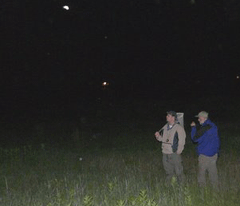
(Photo: Bruce Gellerman)
GELLERMAN: What did you guys get…Adam is going down on the ground.
SOUTH: Right here, if I can grab this female for you guys…she’s on the edge of the grass…and you can see her lantern has just one segment there, which is one way you can distinguish between male and female. Otherwise they look exactly alike. And I saw her respond to a male, so I’ll put her down on the grass so she can attract a male. There she goes
So when you see a firefly flash you’re looking at a well-evolved courtship ritual basically. If you see fireflies flying around you’re probably seeing males. Females mostly stay on the grass and males will fly and flash their species, a specific flash, and the females do their own species specific response so they pretty much only flash because they’re looking for a mate.
GELLERMAN: Ohhh…She’s really…
SOUTH: She’s really flashing.. that’s great.
Gellerman: So that means she’s really hot to trot.
SOUTH: [LAUGHS] I guess so.
GELLERMAN: Now I had heard that there are fake flashes by the female and that she does not have kind things in her heart.

(Photo: Bruce Gellerman)
SOUTH: It’s pretty gruesome. I’ve seen the female Photinus rip the head off the male Photinus and they drink their blood basically because the blood of the Photinus has these compounds called Lucibufagins, which are defensive compounds, which protect the firefly from other predators.
GELLERMAN: what makes fireflies flash? Where does the light come from?
SOUTH: Yes we know what it is. So Inside of the lantern of the firefly are specialized cells called photocytes and inside of those photocytes are two different compounds, there’s an enzyme called luciferase and a substrate luciferins and basically the enzyme, Luciferase, breaks down the luciferin into a product that makes light, basically.
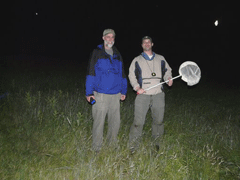
(Photo: Bruce Gellerman)
GELLERMAN: So what’s your intuitive sense: are the number of fireflies going down, is the population being harmed?
SALVATORE: There are things you can look at and say it’s obvious that they’re going down because of habitat destruction, because of light pollution, because of pesticides—but until we get the data we won’t know.
GELLERMAN: To help find out, you can join the Firefly Watch Citizen Scientist project. Check out the link at our web site: L-O-E dot Org.
Related link:
For more information about the Firefly Watch, click here
[MUSIC: The Doors “Light My Fire” from ‘The Doors’ (Elektra Records—1967)]
GELLERMAN: Living on Earth is produced by the World Media Foundation. Our crew includes Ashley Ahearn, Bobby Bascomb, Eileen Bolinsky, Ingrid Lobet, Helen Palmer, Mitra Taj and Jeff Young, with help from Sarah Calkins and Marilyn Govoni.
Our interns are Luke Borders, Kim Gittleson and Jessica Ilyse Smith. Jeff Turton is our technical director. Alison Lirish Dean composed our themes. You can find us at LOE dot org. Steve Curwood is our executive producer. I’m Bruce Gellerman. Thanks for listening.
ANNOUNCER: Funding for Living on Earth comes from the National Science Foundation, supporting coverage of emerging science, and Stonyfield Farm: organic yogurt and smoothies. Stonyfield pays its farmers not to use artificial growth hormones on their cows. Details at stonyfield.com. Support also comes from you our listeners, the Ford Foundation, the Town Creek Foundation, and the Oak Foundation supporting coverage of climate change and marine issues, the Rockefeller Foundation and its campaign for American workers, more at rockfound dot org. And Pax World Mutual Funds: socially and environmentally sustainable investing. Pax World: for tomorrow. On the web at paxworld.com.
ANNOUNCER 2: PRI: Public Radio International.
Living on Earth wants to hear from you!
Living on Earth
62 Calef Highway, Suite 212
Lee, NH 03861
Telephone: 617-287-4121
E-mail: comments@loe.org
Newsletter [Click here]
Donate to Living on Earth!
Living on Earth is an independent media program and relies entirely on contributions from listeners and institutions supporting public service. Please donate now to preserve an independent environmental voice.
NewsletterLiving on Earth offers a weekly delivery of the show's rundown to your mailbox. Sign up for our newsletter today!
 Sailors For The Sea: Be the change you want to sea.
Sailors For The Sea: Be the change you want to sea.
 The Grantham Foundation for the Protection of the Environment: Committed to protecting and improving the health of the global environment.
The Grantham Foundation for the Protection of the Environment: Committed to protecting and improving the health of the global environment.
 Contribute to Living on Earth and receive, as our gift to you, an archival print of one of Mark Seth Lender's extraordinary wildlife photographs. Follow the link to see Mark's current collection of photographs.
Contribute to Living on Earth and receive, as our gift to you, an archival print of one of Mark Seth Lender's extraordinary wildlife photographs. Follow the link to see Mark's current collection of photographs.
 Buy a signed copy of Mark Seth Lender's book Smeagull the Seagull & support Living on Earth
Buy a signed copy of Mark Seth Lender's book Smeagull the Seagull & support Living on Earth

